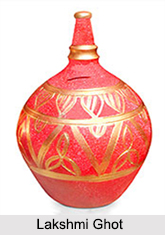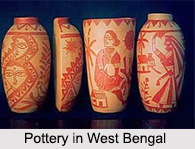 West Bengal in a massive range is popular for its arts and crafts among which pottery painting is one of the most prominent handicrafts of the state. Paintings with different symbols and motifs on the pots exhibit the subtle sense of artistry of the tribal people who dedicate themselves in making these crafts. Pottery art is mostly dominant in the rural parts of West Bengal, which has been practiced by the "Kumhar" community since ages. These pots with exquisite paintings are used for both domestic and ceremonial purposes along with exhibitions of various art galleries around the world.
West Bengal in a massive range is popular for its arts and crafts among which pottery painting is one of the most prominent handicrafts of the state. Paintings with different symbols and motifs on the pots exhibit the subtle sense of artistry of the tribal people who dedicate themselves in making these crafts. Pottery art is mostly dominant in the rural parts of West Bengal, which has been practiced by the "Kumhar" community since ages. These pots with exquisite paintings are used for both domestic and ceremonial purposes along with exhibitions of various art galleries around the world.
Features of Paintings on Pitchers and Pots
The paintings on pitchers and pots bear different symbols with deep significance. Different regions have their own different patterns and features of paintings. Potters of Sonamukhi, Rajgram and Panchmurho produce decorations by drawing only shallow and thin lines. Fish motifs with various geometric designs are the common theme of their paintings. Generally pots are red and black in colour; in some cases earthen vessels are painted in white as well.
 Types of Pottery Paintings in West Bengal
Types of Pottery Paintings in West Bengal
Pottery paintings in West Bengal have been classified in different sections, which are Manasa Ghot, painted urn-shaped pot, Eyo sara etc. These types are focused in details below:
Manasa Ghot: Manasa Ghot is an earthen pitcher which is worshipped as goddess Manasa. In Bengal a "ghot" is worshipped as a deity, which symbolizes any goddess in particular. These "ghots" are decorated with subtle paintings. Manasa Ghot is one of them, which is worshipped as symbol of goddess Manasa. This practice of worshipping Manasa Ghot was originated from East Bengal in the district of Barishal. After the 1947 partition many ghot painters shifted to West Bengal, as a result of which most of the painted ghots can now be found in North 24-Parganas district. Along with Manasa Ghot, some other kinds of ghots are also worshipped as they symbolize other deities and they are Mangal Ghot for all kinds of rituals and ceremonies, Lakshmi Ghot for Lakshmi puja etc.
Manasa Ghots are generally long in shape with engraved paintings, which carry deep significance with them. The image of the goddess Manasa is painted on the body of the ghot maintaining a fine balance between the form and style in a way that the mouth of the ghot may seem to be an ornamental coronet of the Goddess. Manasa"s hands are shown to be gripping snakes in clenched fists. Single strokes have been used to manifest her lips and chin, traditional nose-ring, eyebrows, the three eyes and the fingers of her hand. Often the base of the ghot is decorated with lotus designs to symbolize it as the seat of the Goddess.
 Painted Urn-Shaped Pot: Earlier days, urn-shaped pots were used to deliver sweets (especially prepared as wedding gifts). These pots are decorated with different types of paintings and covered with earthen lids, the edges of which are curved downwards. Flower, leaves and creature motifs are used in paintings to decorate the pots among which lotus, fish, butterfly, betel leaves etc are the most common ones. Bright colours like red, blue, yellow and green are used to complete the decorations.
Painted Urn-Shaped Pot: Earlier days, urn-shaped pots were used to deliver sweets (especially prepared as wedding gifts). These pots are decorated with different types of paintings and covered with earthen lids, the edges of which are curved downwards. Flower, leaves and creature motifs are used in paintings to decorate the pots among which lotus, fish, butterfly, betel leaves etc are the most common ones. Bright colours like red, blue, yellow and green are used to complete the decorations.
In Rajnagar, Siuri and other areas of Birbhum, there is a popular ritual of putting six or eight such painted pots under a canopy, under which a wedding ceremony takes place. People of Kandi area of Murshidabad District use these pots to send sweets as wedding gifts; Muslim community of Howrah and Medinipur districts decorate these pots with red and white colours to use them for the same purpose. The artisans of Medinipur district also sale these earthen pots in village fairs.
Eyo Sara: Eyo Sara, earthen vessels similar to urn-shaped pot, was used during weddings. The word "sara" means shallow plate. This pot is covered with a shallow plate and its upper end is shaped like a pinnacle of temple with a peacock on the top of it. The lower part of it is encompassed by 14 dolls dressed in skirts. These pots are not in use in modern days; they are now exhibited in the Ashutosh Museum.



















